It seems one can’t swing a cat without hitting a coyote, a jackrabbit, a Canada goose, or a bear – and not just in the far-flung wilderness. Wildlife encounters are now common in cities, with urban populations of coyotes, skunks and Canada geese increasing throughout North America.

Colleen Cassady St. Clair
Here are four tips on making wildlife encounters of every description safe and enjoyable for all parties involved from University of Alberta behavioural ecologist Colleen Cassady St. Clair.
Don’t feed them anywhere, any way, any how
This is the Golden Rule of wildlife interaction, St. Clair says.
“Feeding wildlife is a really bad idea,” she says. “The animals become ‘food conditioned,’ a term we use when they associate people with food and become very aggressive. Usually that behaviour can’t be reversed, and food conditioned carnivores are often destroyed to protect public safety.”
And while you might know not to hand a cheeseburger to a grizzly bear, St. Clair says that a surprising amount of “food conditioning” happens unintentionally. Urban coyotes, for example, will eat compost, bird seed, uncontained garbage and fallen fruit if they can get their paws on it.
This can be bad news not just for animals but for humans as well, St. Clair says. For example, feeding wild deer has been shown to spread chronic wasting disease, a neurological disorder similar to mad cow disease that has spread rapidly in North America. A new-to-Alberta tapeworm strain that infects coyotes can also infect dogs and, alarmingly, humans. St. Clair estimates about 60 percent of coyotes in the Edmonton, Alta. area have it, and 21 people in Alberta have been diagnosed.
“Any aggregation of wild animals makes them more susceptible to disease,” she says.
Common causes of concentration include bird feeders, where our flappy friends can pass eye-infecting conjunctivitis to each other. St. Clair further cautions against bird feeders as they are often inadvertent boosts to the house sparrow, which is invasive and hyper-abundant in North America. They can also attract concentrations of mice, squirrels, voles and rabbits.
Respect their space
Getting too close is another common mistake in wildlife encounters, St. Clair says.
“Don’t get too close,” she says. “If you’ve done it inadvertently, try to back up slowly. Don’t turn and run, as that will invite some animals to chase, especially if they are a predator. Speak to the animal in a firm voice while backing away.” We can coexist with urban coyotes by intimidating them so they keep their distance from people by shouting, throwing things, even charging at them, she says of this particular species. “People shouldn’t use intimidation with most predators or even ungulates, but I do recommend it for coyotes.”
So how far is far enough? Safe distance guidelines vary by species and by the time of year. However, most animals will be more aggressive when young animals are around.
“Moms get very aggressive around their babies, and not only predators,” says St. Clair. “More people are injured each year by elk and moose than bears for this reason, so extra care around wildlife is warranted in spring and early summer.”
Pause to enjoy it
St. Clair is one of North America’s foremost experts on wild animal behaviour and observation. She has studied everything from bears to mice to elk to wolves. She got started in behavioural ecology by closely watching penguins on the west coast of New Zealand.
Looking at a wild animal, she says, is one of the most enjoyable things you can do with your time.
“The first thing I recommend when you see a wild animal is to pause and enjoy the moment,” she says. “Almost everyone is fascinated by wild animals. Psychologists have shown that a person watching an animal gets a huge dopamine hit just from seeing it in a natural setting.”
Put it on the ’gram (and beyond)
St. Clair is a major proponent of taking and sharing pictures or video of an encounter with a wild animal.
“Digital tools like smartphones have created so many ways for people to record their wildlife observations,” she says. “The power of having so many people watching wildlife and sharing what they see is changing how we do research.”
For instance, she and her students recently submitted a paper based on 10,000 crowd-sourced observations of urban coyotes from citizens using the Urban Coyote Project. (You can still contribute observations if you want to get involved.)
St. Clair is a big fan of iNaturalist, an open wildlife identification platform. Any user can submit a photo for expert analysis. The photo may also contribute to global biodiversity research and St. Clair’s team will use it for a new project on elk.
The history of our relationship with the untamed parts of the animal kingdom is not a uniformly pleasant one. Practising these tips from St. Clair can make your next walk on the wild side a peaceful affair for all parties involved.
| By Lewis Kelly
Lewis is a reporter with the University of Alberta’s New Trail online magazine. The University of Alberta is a Troy Media Editorial Content Provider Partner.
The opinions expressed by our columnists and contributors are theirs alone and do not inherently or expressly reflect the views of our publication.
© Troy Media
Troy Media is an editorial content provider to media outlets and its own hosted community news outlets across Canada.


